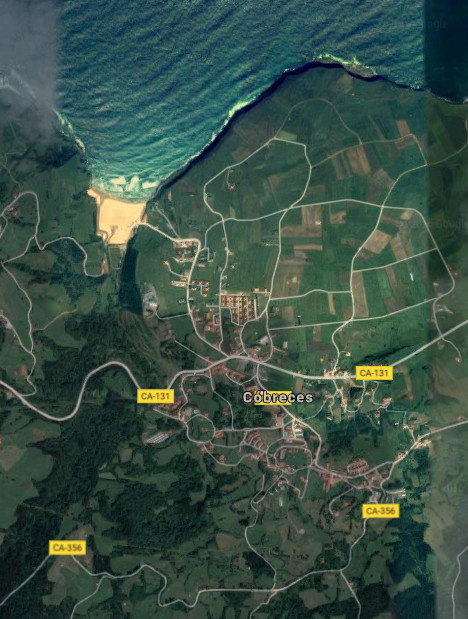Cobreces, villa
![]()
Cóbreces es una pequeña localidad costera perteneciente al municipio de Alfoz de Lloredo. Emplazado en la costa occidental de Cantabria, su núcleo urbano dista apenas 500 metros de la playa de Luaña. La configuración del litoral, en esta zona, abre una ensenada que termina desembocando en el arenal. El entorno acompaña a su singularidad. Conserva un estado natural semisalvaje, rodeado de praderas, colinas,acantilados y bosques.
Los orígenes de la villa se remontan al siglo X. El testimonio y registro de su historia es el patrimonio arquitectónico. La arquitectura civil destaca con edificios como el Palacio de Villegas, Casal de Castro y el Instituto Agrícola Práctico Quirós; edificio construido en el siglo XX sobre la antigua casa del linaje de Quirós. La arquitectura religiosa refleja los pasos de la historia y el camino de los linajes. El lugar que ocupaba el antiguo monasterio de San Félix del siglo X es el actual emplazamiento de la Iglesia de San Felices de Mies, del siglo XV. La Abadía de Santa María de Viaceli, la Ermita de Santa Ana o La Iglesia de San Pedro Ad vincula son otros ejemplos de su riqueza.
La costa acantilada e irregular de Cóbreces descubre en su trazado varias zonas a modo de mirador. La altura del litoral, la naturaleza que puebla de praderas hasta su borde y el Mar Cantábrico son algunos de los ingredientes que producen un lugar idílico e idóneo para disfrutar del esparcimiento. El acantilado de Bolao es una muestra de su costa. El acceso por carretera comarcal desemboca en un pequeño aparcamiento campestre. A 200 metros aparecen restos de los antiguos molinos de marea, el sonido del océano es proyectado hacia tierra y las lastras que contiene la formación, presentan el espacio a la vista.
![]() Cóbreces is an small coastal locality belonging to the municipality of Alfoz de Lloredo. Located on the western coast of Cantabria, its urban core is far scarcely 500 meters of Luaña’s beach. The configuration of the littoral, in this zone, opens an inlet that finally ends in the sandbank. The environment accompanies to its singularity. There preserves a semi-wild nature, surrounded with meadows, hills, cliffs and forests.
Cóbreces is an small coastal locality belonging to the municipality of Alfoz de Lloredo. Located on the western coast of Cantabria, its urban core is far scarcely 500 meters of Luaña’s beach. The configuration of the littoral, in this zone, opens an inlet that finally ends in the sandbank. The environment accompanies to its singularity. There preserves a semi-wild nature, surrounded with meadows, hills, cliffs and forests.
The origins of the villa go back to the 10th century. Testimony and record of its history is the architectural heritage. The civil architecture stands out with buildings as Villegas’s Palace, Casal de Castro and the Agricultural Practical Institute Quirós; building constructed in the 20th century over the former house of Quirós’s lineage. The religious architecture reflects the steps of the history and the way of the lineages. The place that was occupying San Félix’s former monastery of the 10th century is the current emplacement of San Felices de Mies Church, of the 15th century. The Abbey of Santa Maria de Viaceli, the Hermitage of Holy Ana or San Pedro Ad vincula Church are other examples of its wealth.
The steep and irregular coast of Cóbreces discovers in its tracing several zones as viewing-point. The height of the littoral, the nature that populates with meadows up to its edge and the Cantabrian Sea are some of the ingredients that produce an idyllic and suitable place to enjoy the scattering. Bolao’s cliff is a sample of its coast. The access, by regional road, ends in a small rural parking. In 200 meters there appear remains of the former mills of tide, the sound of the ocean is projected towards land and the flagstones that contains the formation , present the space at sight.
![]()
 Cobreces, village
Cobreces, village


